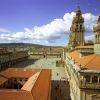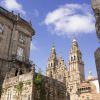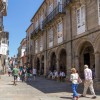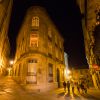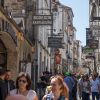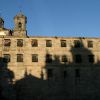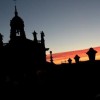- Accede I
- Regístrate I
- carrito
Plaza de la Inmaculada
La Plaza de la Inmaculada está enmarcada entre el monasterio de San Martiño Pinario y la fachada catedralicia de la Azabachería , que debe su nombre a la tradicional presencia de talleres dedicados a la talla del azabache. Allí desemboca el último tramo urbano de los Caminos Francés, Inglés y del Norte, que entra al casco histórico por la llamada Puerta del Camino.
La primitiva fachada Norte de la catedral aparece descrita en el Códex Calixtino del siglo XII como ‘ la Puerta del Paraíso', no sólo por su belleza, sino porque representaba la historia de Adán y Eva, el pecado original y la redención. Ante ella estaba la Fons Mirabilis , fuente hoy trasladada al claustro, en la que se aseaban los peregrinos antes de entrar a la catedral. El ambiente medieval se completaba con las mesas de los cambistas de dinero, mezclados con vendedores de calzados, cuero y especias, y posaderos que ofrecían alojamiento.
Hoy la fachada norte de la Catedral muestra trazas barrocas y neoclásicas, pues fue reformada por entero en el siglo XVIII.
Monasterio de San Martiño Pinario
Fue fundado en el siglo X para albergar a un grupo de monjes cuya tarea era vigilar el culto a las reliquias del Apóstol. Su extensión de más de 20 mil metros cuadrados lo convierte en el segundo mayor de España, sólo superado por El Escorial. En 1494 pasó a depender de la congregación benedictina de Valladolid y un año más tarde participaba en la fundación del Estdio Viejo, que dio origen a la Universidad. Ya entonces era el más importante monasterio del territorio, y sus rentas, provenientes de toda Galicia, le permitían en el siglo XVIII dar limosna a centenares de pobres -un día a los hombres, otro a mujeres y niños- alternando con el arzobispo. Hasta su supresión en 1837, poseía la mayor biblioteca de Galicia y uno de los mayores albergues del país.
El edificio actual muestra una fachada barroca que fue rematada en 1738 con un cierre central barroco. Sobre el gran escudo de Carlos V puede verse la imagen ecuestre del santo titular, San Martín de Tours, que parte su capa con un pobre. En su interior, que es parte del Seminario Mayor y sólo abre sus puertas como hostal en verano, se distribuyen tres imponentes claustros de los siglos XVII y XVIII.










